By William Cooke
“It was just hooted at, the idea that you’d ever get people out of the automobile. They’d never come to San Francisco if they couldn’t drive into San Francisco.” — Mary Ellen Leary, journalist
“The formation of BART is actually one of the funniest things that ever transpired.”
— George Christopher, Mayor of San Francisco
On September 11, 1972, an estimated 15,000 people rode Bay Area Rapid Transit (BART) on its very first day of operation. The train system, which at that time was a fraction of its current size, has been a vital service to Bay Area commuters for 50 years now. Those with an interest in the history of the Bay Area’s rapid transit system, or regional planning and public transportation more generally, will find a treasure trove of information in the UC Berkeley Oral History Center’s (OHC) archive.
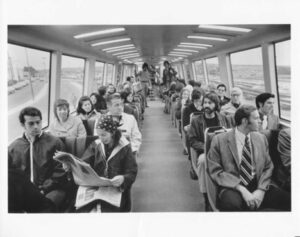
But BART’s development is much more than a history of a public planning project. It is also a history of the evolution of government and of local versus regional power sharing. The OHC houses oral histories from big and small players in California’s public administration throughout the entire 20th century. The voices of politicians, journalists, city planners, and others reveal that BART’s development brought about a whole slew of questions regarding the proper role of government at all levels and required a great deal of reciprocity.
Mary Ellen Leary, a journalist who got her start with San Francisco News, studied and wrote extensively about urban planning and development in the early 1950s. In her oral history “A Journalist’s Perspective: Government and Politics in California,” she speaks at length about the origins of BART, and the broader development of regional agencies designed to meet the transportation needs of suburban areas, not just cities. “I felt then and still feel that the degree of local participation generated for BART from the first planning funds to the final bond issue was an extremely interesting and important political development.”
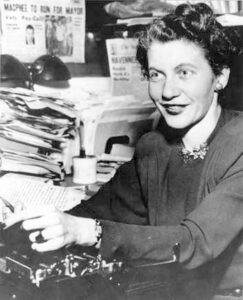
Leary says the impetus to begin work on a regional transit system originated in concerns about traffic congestion in the Bay Area. At the time, however, the idea of an alternative to driving in San Francisco seemed absurd. After all, BART would become the first new regional transit system built in the U.S. in 65 years.
But this worry about compact little San Francisco and the automobile launched this idea about rapid transit. And I laugh now about everybody giving BART such a hard time. It was just hooted at, the idea that you’d ever get people out of the automobile. They’d never come to San Francisco if they couldn’t drive into San Francisco.
According to Leary, local businessman Cyril Magnin and San Francisco Supervisor Marvin Lewis were among the first to consider the benefits of investing in a public transit system instead of parking garages. Unlike Los Angeles, the Bay Area could not build enough parking lots and garages to meet the needs of a car-reliant city due to limited space. Leary observes:
At any rate, they got a group of some business people to take seriously the idea of “How is San Francisco going to endure the flood of traffic that’s already coming in from the Golden Gate Bridge and the Bay Bridge? We can’t possibly do it.” The figures were coming out about what percentage of downtown Los Angeles was given over to automobile parking, most of it on the surface. They hadn’t yet begun many multiple-level parking facilities.
Eventually three counties — San Francisco, Alameda, and Contra Costa — committed to the transit system and developed the “BART Composite Report.” This had to be approved by their respective county supervisors in order for a bond measure to be placed on the San Francisco Bay Area Rapid Transit District-wide ballot in November of 1962.
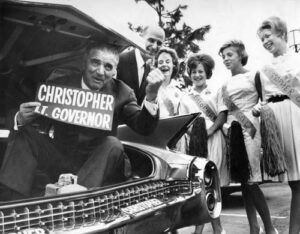
In his oral history, longtime Republican politician and former Mayor of San Francisco from 1956–1964, George Christopher, remembers seeking the crucial aye vote of the fifth and still undecided Contra Costa County supervisor, Joe Silva. Silva had been under pressure from his constituents to vote no, because they would not directly benefit from the commuter rail but would bear the high price tag. Without Silva’s vote, the eventual passage of the measure in November and the $792 million bond issue may have been set back by years. According to Christopher, “The formation of BART is actually one of the funniest things that ever transpired,” involving a pre-dawn meeting and donuts.
I called him and I said “Supervisor, you’re the important man here. Now what are we going to do about this? All I’m asking is that you put it on the ballot and let the people decide whether they want it or not…. I said, “What time shall we meet?” He said, “Five o’clock in the morning.”… Sure enough we got up at four o’clock in the morning and we went over to Contra Costa County and finally found this restaurant. It turned out to be a little donut shop with no tables, no tables whatever, and we all sat around the counter. Here were all the teamsters, the truck drivers listening to every word we had to say…. I don’t know how many donuts we had, but we certainly filled ourselves.
Many hours and donuts later, Christopher had earned Silva’s crucial “yes” vote in support of the regional rail system. Christopher’s oral history is part of the Oral History Center’s “Goodwin Knight-Edmund G. ‘Pat’ Brown, Sr. Oral History Series,” which covers the California Governor’s office from 1953 to 1966, and is a gold-mine of fascinating anecdotes on city planning and transportation issues during that crucial decade.
Even before the bond issue was put on the ballot and approved in 1962, a consequential battle for regional power over transportation, including BART, was fought, ultimately resulting in a victory for local influence in this regional system. This battle was reflected in the approximately three-year long struggle between the Golden Gate Authority (GGA) and its younger competitor, the Association of Bay Area Governments (ABAG), for control over the planning and operation of transportation infrastructure in the region. Several oral histories from the Oral History Center discuss the importance of ABAG, which refers to itself as “part regional planning agency and part local government service provider.” In the oral history titled “Author, Editor, and Consultant: A Participant from the Institute of Governmental Studies,” Stanley Scott, a research political scientist at UC Berkeley, explains:
It came more from the large business interests, the Bay Area Council, with Edgar Kaiser being the chief proponent and front man, I guess you’d say, to create a Golden Gate Authority. That would incorporate the ports, the airports, and the bridges, the bridges being brought in essentially because they were very profitable organizations. So that one kind of came in, you might say, from the side, but at the same time, also involving regional restructuring.
This really upset the cities and counties, and quite a few others. A lot of people were concerned about it. A lot of people were concerned about just latching on to the bridges and tying them in with the airports and seaports. What are we going to do about all the other transportation problems? There was a great deal of concern.
It also exercised cities and counties that just did not want a major authority coming in from off the wall, so to speak. They began organizing themselves, and that was, in part, the genesis of ABAG. It was not the only reason for ABAG’s creation, but it provided substantial push in that direction. It had a lot to do with it. It scared the local people. That would have been in ’58, ’59, and ’60, that the Golden Gate Authority idea was kicked around. It was over a period of at least two years, and it could have been three, before it finally bit the dust.
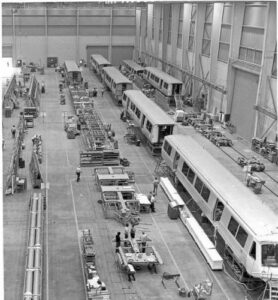
T.J. Kent also addresses this theme about local influence and power sharing — with a focus on the role of ABAG — in his oral history, “Professor and Political Activist: A Career in City and Regional Planning in the San Francisco Bay Area.” Kent was a prominent city planner under San Francisco Mayor Roger Lapham in the 1940s, a deputy mayor for development under Mayor John Shelley in the 1960s, served on the Berkeley city council in the 1950s, and was a founder of UC Berkeley’s Department of City and Regional Planning.
According to Kent, former Mayor George Christopher opted to keep San Francisco out of ABAG because he felt that San Francisco was too important a player in the region to enter into an equal-representation regional government. His successor, Mayor John F. Shelley, reversed that policy, bridging the way to cooperation between the Bay Area’s largest city and the influential agency.
Shelley, with the board of supes [supervisors] backing him, he brought San Francisco into ABAG and appointed me as his deputy on the ABAG executive committee. I also served as the mayor’s deputy on the ABAG committee on goals and organization….The Committee prepared the regional home rule bill that was adopted by ABAG in 1966… It called for a limited function, directly elected, metropolitan government. That’s the key report.
Indeed, the publication of the Regional Home Rule and Government of the Bay Area report marked a huge milestone in the actualization of BART. ABAG, which was granted the authority by the State of California in 1966 to receive federal grants, included BART in the four elements of its metropolitan plan. Kent explains:
The first is the central district, enlarged and unified and focused in San Francisco; the second is a regional, peak-hour commuter transit system, which is BART and AC transit, plus the other transit systems serving San Mateo County, San Francisco and Marin and Sonoma counties; third is the open space system, to keep things from sprawling and for basic environmental reasons; and the fourth was comprised of the region’s residential communities, which shouldn’t get too dense, too overbuilt.
ABAG’s ability to receive and use federal money would prove vital to BART’s construction and continued operation. Furthermore, city and county representation on ABAG’s board — as opposed to zero locally elected officials in the defunct Golden Gate Authority — meant that cities likely had more of a say in the planning of BART than they would have had under the administration of the GGA.
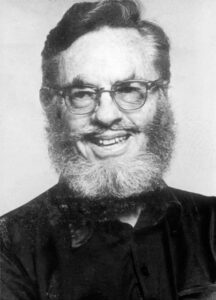
Kent, then a Berkeley city councilmember, helped write the ABAG bylaws that balanced regional and local power. Kent believed in the importance of assigning enough power to regional agencies and districts like ABAG and BART, while also maintaining local autonomy. According to Kent — who throughout his oral history stresses the need to protect home rule wherever possible — counties that opted to stay in the Bay Area Rapid Transit District sometimes felt that the District was too restrictive or overbearing. But as a regional representative government with limited authority, conflicts were eventually solved. Kent remembers the back-and-forth between BART and Berkeley prior to the bond issue passing in 1962.
But those [counties] that were left in [the District], there were major battles in the BART legislation because the BART legislation had to give that agency that power and right. I was on the Berkeley council at the time and the battles were serious. There were many things that BART was required to do in consulting the cities and counties before the bond issue was proposed and voted on in 1962 and even after, which I think was good. They required BART to deal with Berkeley as an equal when Berkeley said, “We think—.” Berkeley got tremendous concessions from BART before the bond issue. You may not realize it, but the initial 1956 BART plan for the Berkeley line had it elevated all the way through downtown. Berkeley fought back before the bond issue vote of ʼ62 and got the middle third put underground.
Those counties that decided to stay in the District and cooperate with BART during its construction had a say in the decision-making process. Perhaps due to that fact, the 1962 district-wide bond issue surpassed the required 60% approval threshold, a result that came as a surprise to many political experts. Litigation and negotiations ensued with cities and counties across the Bay Area in the years that followed. But without the initial bond issue, BART could not have even begun construction.
Mary Leary observed that the impetus to create a regional, commuter rapid transit system — as well as the process of planning BART — did much to encourage local participation in politics. Even though ABAG was a regional entity with certain powers over local governments, Leary says that the agency allowed local governments a say in BART’s planning.
I think it was not unrelated that during this same era of local sharing in BART plans on a regional basis the Supervisors Association and the League of California Cities together launched ABAG, Association of Bay Area Governments, a voluntary group of cities and counties to discuss regional problems. It did not become a real regional government. In fact, I always felt it was created by those two groups to thwart moves towards regional government and to make sure cities and counties maintained their own strong voices. But it has been a significant forum and I think cooperation of the various governments around the Bay in planning BART gave it a good start. Interestingly, when planning got underway for where BART’s lines should run and stations should be, this became the first regional planning ever undertaken and local communities could see as some did that they were planning a sewer outfall just where the next-door neighbor town was planning a beach resort, that sort of thing.
In her oral history, Leary also noted a change in public perspective about public transit — away from the idea that no one would visit San Francisco if they couldn’t drive, to voters actually rejecting federal funds for a freeway connecting the Golden Gate and Bay bridges — and the relationship of BART to that.
Anyway, there was a good deal of political pride in the area that they had shared in developing BART from the very start, and it was part of the system’s success. Most other cities sat back and waited for Washington to provide funds for transit. Los Angeles never could get that much regional support. Of course, about that same time San Francisco was so supportive of the transit idea it rejected federal money for a freeway connection between the Golden Gate Bridge and the Bay Bridge. That really stirred a lot of national attention, saying “no” to millions or maybe billions.
Those interested in exploring the history of BART further, or learning more about the central themes of its history — local and regional government power sharing in the Bay Area, effective organization of regional governing bodies, and local participation in city planning, to name a few — can find much more in OHC’s numerous projects and individual interviews. Search by name, keyword, and several other criteria from the OHC home page.
William Cooke is a fourth-year undergraduate student majoring in Political Science and minoring in History. In addition to working as a student editor for the Oral History Center, he is a reporter in the Sports department at UC Berkeley’s independent student newspaper, The Daily Californian.
About the Oral History Center
The Oral History Center of The Bancroft Library has interviews on just about every topic imaginable. You can find the interviews mentioned here and all our oral histories from the search feature on our home page. Search by name, keyword, and several other criteria. We preserve voices of people from all walks of life, with varying political perspectives, national origins, and ethnic backgrounds. We are committed to open access and our oral histories and interpretive materials are available online at no cost to scholars and the public. Sign up for our monthly newsletter featuring think pieces, new releases, podcasts, Q&As, and everything oral history. Access the most recent articles from our home page.
Related Oral History Center Projects
Covering the years 1953 to 1966, the Oral History Center (then the Regional Oral History Office) began the Goodwin Knight-Edmund G.Brown, Sr., Oral History Series of the State Government History Project in 1969. It covers the California Governor’s office from 1953 to 1966 and contains 84 interviews with a diverse set of personalities involved in Californian public administration. Topics include but are not limited to the rise and decline of the Democratic party, the impact of the California Water Plan, environmental concerns, and the growth of federal programs. This series includes the multivolume “San Francisco Republicans,” which includes the oral history of George Christopher, “Mayor of San Francisco and Republican Party Candidate.”
The San Francisco-Oakland Bay Bridge Oral History Project, launched in May of 2012, is a collection of 15 interviews that cover the construction of the Bay Bridge, maintenance issues, and the symbolic significance of the bridge in the decades after its construction. The majority of interviewees in this project spent their careers working on or around the bridge as architects, painters, toll-takers, engineers and managers, to name a few.
The California Coastal Commission Project traces the development of the only California commission voted into existence by the will of the people, from the campaign for Proposition 20 that created the agency in 1972 to the various development battles it confronted in the decades that followed. These interviews document nearly a half century of coastal regulation in California, and in the process, shed new light on the many facets involved in environmental policy.
Listen to the “Saving Lighthouse Point,” podcast, a collaboration between the OHC and the Bill Lane Center for the American West at Stanford University. “Saving Lighthouse Point” tracks the successful effort by citizens of Santa Cruz, with the support of the California Coastal Commission, to block the development of a bustling tourist and business hub on one of the last open parcels of land in the city.
Related Resources from The Bancroft Library
City and regional planning for the Metropolitan San Francisco Bay area, Kent, T. J., 1963. Bancroft Library/University Archives, Bancroft ; F868.S156K42
Open space for the San Francisco Bay area; organizing to guide metropolitan growth, Kent, T. J., 1970. University of California, Berkeley. Institute of Governmental Studies. Bancroft Library/University Archives. Bancroft ; F868.S156.57.K4
Regional plan, 1970–1990 – San Francisco Bay region, Association of Bay Area Governments, 1970. Bancroft Library/University Archives. Bancroft Pamphlet Double Folio ; pff F868.S156.8 A82
The BART experience: what have we learned? Webber, Melvin M.; University of California, Berkeley. Institute of Transportation Studies. 1976. Bancroft Library/University Archives. UC Archives ; 308m r42 W372 b